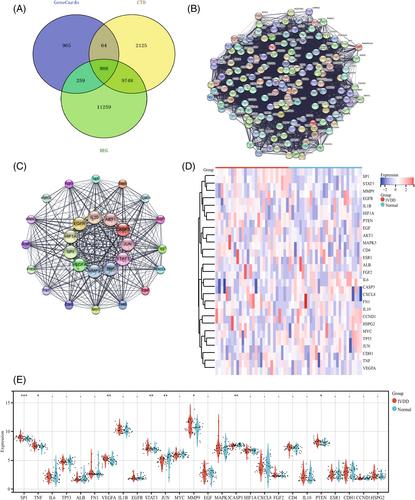Intervertebral disc degeneration (IVDD) is a common chronic disease in orthopedics, and its molecular mechanisms are still not well explained.
This study's objective was to bioinformatics-based discovery of IVDD biomarkers and immune-inflammatory infiltrates.
The IVDD illness gene collection was gathered from GeneCards, DisGeNet, and gene expression profiles were chosen from the extensive Gene Expression Omnibus database (GSE124272, GSE150408, and GSE153761). The STRING database was used to create a network of protein–protein interactions, while the Kyoto Encyclopedia of Genes and Genomes (KEGG) and Gene Ontology (GO) databases were used for functional enrichment analysis. Using hub genes, the immune cell infiltration between IVDD patient samples and control tissues was examined. Finally, quantitative polymerase chain reaction and Western blot experiments were used to verify the expression of hub genes.
A total of 27 differentially expressed hub genes were identified by bioinformatics. According to GO and KEGG analyses, hub genes were prominent in immunological responses, chemokine-mediated signaling pathways, and inflammatory responses, with the key signaling pathways engaged in cellular senescence, apoptosis, Th1 and Th2 cell differentiation, and Th17 cell differentiation. Immune cell infiltration research revealed that T cells, lymphocytes, B cells, and NK cells were decreased in IVDD patients while monocytes, neutrophils, and CD8 T cells were increased. The expression levels of the senescence hub genes SP1, VEGFA, IL-6, and the apoptosis key gene CASP3 were considerably greater in the IVDD model group than in the control group, according to in vitro validation.
In conclusion, the cellular senescence signaling pathway, the apoptosis signaling pathway, and associated hub genes play significant roles in the development and progression of IVDD, this finding may help direct future research on the senescence signaling route in IVDD.



